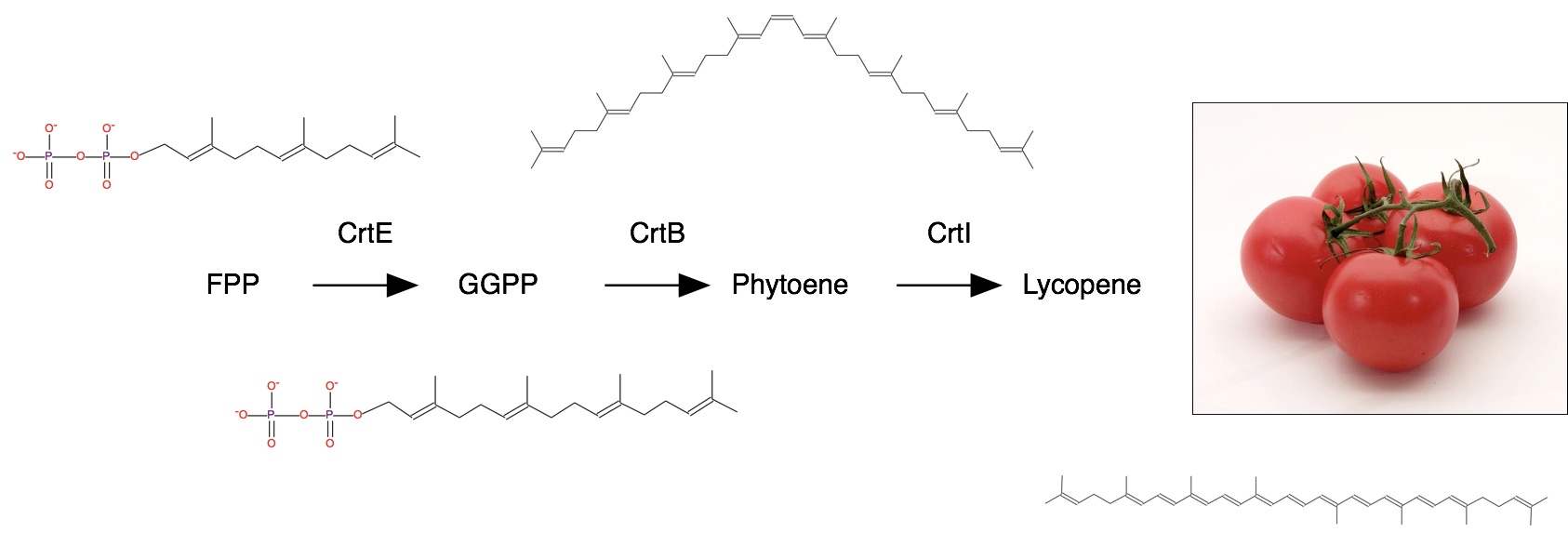Bio Production
Patrick Boyle (Ginkgo Bioworks)
Recordings
- Will be linked after class
Presentations and slides
- Will be linked after class
Class assignments
Lycopene is the red pigment that gives tomatoes their color. This pigment is also made by microbes. In fact, transferring a 3-enzyme pathway to E. coli can convert farnesyl diphosphate (FPP) to lycopene. For the laboratory portion of this assignment, you will characterize lycopene production in E. coli. The computational tools and databases presented today can also be used to enhance lycopene production in E. coli or even produce different colors by adding additional genes.

Part I: Test pAC-LYC plasmid
The pAC-LYC plasmid is available from Addgene, and contains three genes from Erwinia herbicola: CrtE, CrtI, and CrtB. This plasmid is provided by Addgene on an agar stab transformed into Top10 E. coli. That means that it can simply be streaked onto LB Agar with chloramphenicol to make lycopene-producing colonies that should be pink to red in color.
Link to pAC-LYC in Addgene: https://www.addgene.org/53270/
Advanced users may want to isolate the pAC-LYC plasmid DNA from E. coli via a miniprep, so that it can be transformed into other E. coli strains. In addition, purifying the plasmid will allow modification via the gene editing tools presented in previous lectures. Pure plasmid can also be co-transformed with other compatible plasmids containing other pathway enzymes to enhance or modify lycopene production. For example, the pAtipiTrc plasmid (https://www.addgene.org/53275/) can be co-transformed with pAC-LYC in E. coli, and plated on LB agar with ampicillin and chloramphenicol. The pAtipiTrc plasmid contains a copy of the idi gene from Arabidopsis thaliana, idi overexpression leads to increased lycopene production. Therefore, E. coli containing both pAtipiTrc and pAC-LYC plasmids will be darker red than E. coli only containing pAC-LYC.
Part II: Design strategies for increasing lycopene production
Using tools such as Biocyc (https://www.biocyc.org) and KEGG (http://www.kegg.jp), select enzymes that can be added to (or knocked out of) your lycopene-producing E. coli to increase the amount of lycopene they produce. The pAtipiTrc plasmid available in Addgene represents one possible strategy, as it overexpresses a heterologous idi enzyme. Labs working with PCR and cloning may want to try replacing the idi gene in pAtipiTrc with alternative enzymes to see how they impact colony color.
Part III: Design strategies for converting lycopene to beta-carotene
Use Biocyc and/or KEGG to identify the enzyme that can convert the red pigment lycopene to the orange pigment beta-carotene. Plasmids that can be co-transformed with pAC-LYC that produce this enzyme can be found in Addgene. Labs working on miniprep and transformation can order these plasmids to observe switch the color of their E. coli from red to orange.